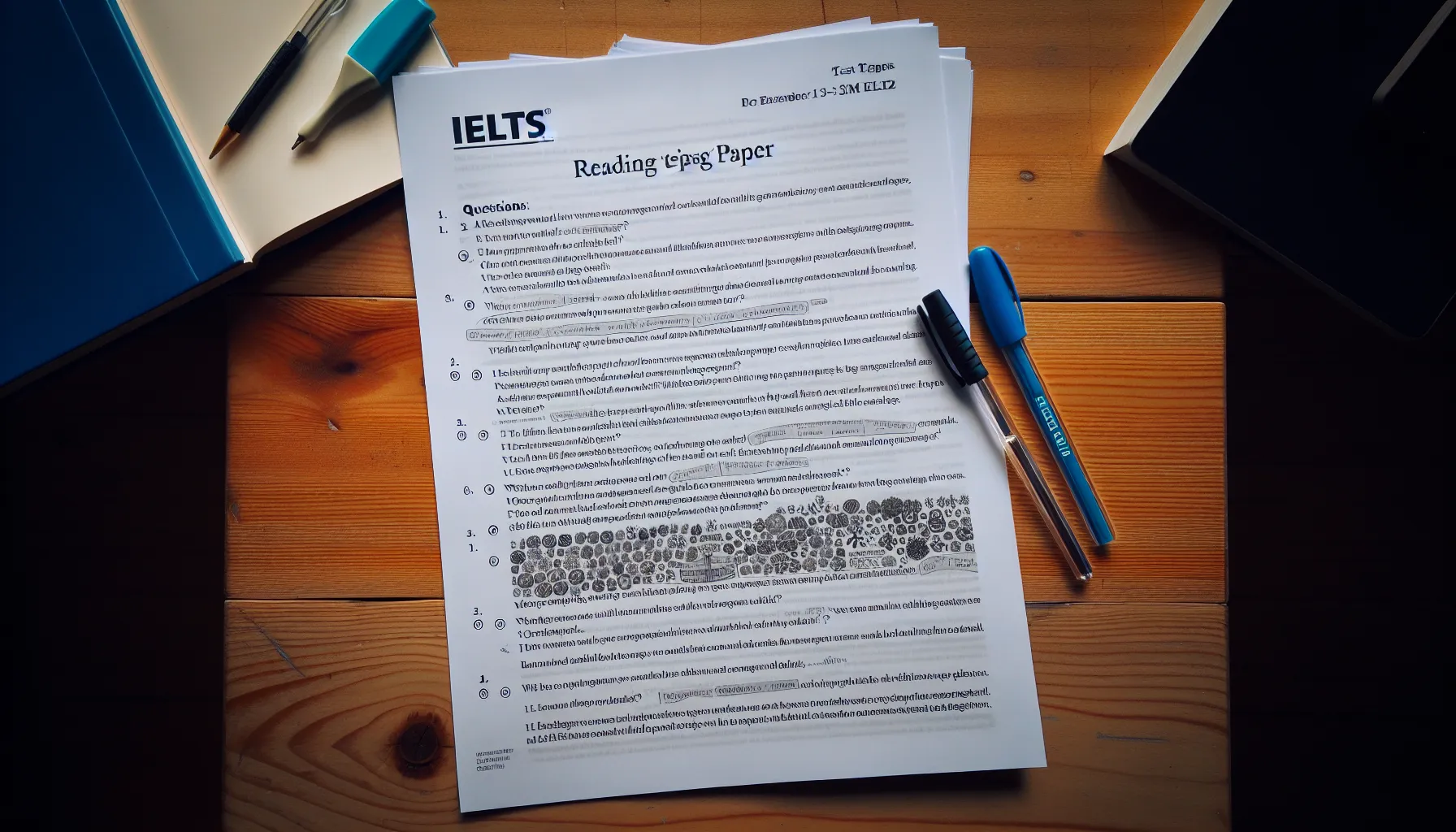In the IELTS Reading test, candidates often encounter passages that explore diverse topics, including cultural differences in education assessment methods. This article provides a comprehensive practice test focusing on this subject, offering valuable insights into how various cultures approach educational evaluation. Let’s dive into a full IELTS Reading test, complete with passages, questions, and answers to help you prepare effectively for your exam.
 IELTS Reading Test Paper
IELTS Reading Test Paper
IELTS Reading Practice Test
Passage 1 – Easy Text
Cultural Approaches to Educational Assessment
Education is a cornerstone of society, and the methods used to assess student performance vary significantly across cultures. In some countries, standardized testing is the norm, while others prioritize project-based assessments or oral examinations. These differences reflect underlying cultural values and beliefs about learning and success.
In the United States, for example, multiple-choice tests and quantitative metrics are widely used to evaluate student progress. This approach aligns with the cultural emphasis on individual achievement and measurable outcomes. Conversely, many European countries employ a more holistic assessment strategy, considering factors such as critical thinking skills and creativity alongside traditional academic knowledge.
Asian education systems, particularly in countries like China and South Korea, often rely heavily on high-stakes examinations. These tests, such as the gaokao in China, can determine a student’s entire academic and professional future. This reflects a cultural belief in the power of hard work and the importance of academic excellence.
In contrast, some Nordic countries have moved towards a more egalitarian approach to assessment. Finland, for instance, has eliminated standardized testing in favor of teacher-led evaluations and a focus on individual student growth. This method aligns with the Finnish cultural value of equity in education.
Indigenous communities often have unique approaches to educational assessment that differ markedly from Western models. Many emphasize oral tradition and practical skills, assessing students based on their ability to contribute to the community rather than on written exams or grades.
Understanding these cultural differences in assessment methods is crucial for educators working in increasingly diverse and globalized classrooms. It also highlights the need for a more nuanced approach to international comparisons of educational outcomes.
Questions 1-7
Do the following statements agree with the information given in the passage? Write
TRUE if the statement agrees with the information
FALSE if the statement contradicts the information
NOT GIVEN if there is no information on this
- All countries use the same methods to assess student performance.
- The United States favors quantitative assessments like multiple-choice tests.
- European countries only consider traditional academic knowledge in their assessments.
- High-stakes examinations in Asian countries can significantly impact a student’s future.
- Finland has completely abandoned all forms of student assessment.
- Indigenous communities prefer written exams over practical skills assessment.
- Educators in diverse classrooms benefit from understanding different assessment methods.
Questions 8-10
Complete the sentences below. Choose NO MORE THAN TWO WORDS from the passage for each answer.
- The Chinese university entrance exam is called the ____.
- Finland’s approach to assessment reflects their cultural value of ____ in education.
- Many indigenous communities emphasize ____ and practical skills in their educational assessments.
Passage 2 – Medium Text
The Evolution of Assessment Methods in Higher Education
The landscape of higher education assessment has undergone significant transformations over the past few decades, reflecting broader changes in educational philosophy, technology, and societal expectations. Traditional methods of evaluation, such as end-of-term examinations and standardized tests, while still prevalent, are increasingly being supplemented or replaced by more diverse and nuanced approaches.
One notable shift has been towards continuous assessment, where students are evaluated throughout their course of study rather than solely at its conclusion. This method allows for a more comprehensive view of a student’s progress and can help identify areas for improvement early on. It also aligns with the growing recognition that learning is a process, not just an outcome.
Another trend is the increasing use of authentic assessment techniques. These methods aim to evaluate students’ abilities in real-world contexts, often through project-based learning, case studies, or simulations. For instance, business students might be assessed on their performance in managing a virtual company, while medical students might be evaluated on their interactions with simulated patients.
Technology has played a crucial role in expanding the possibilities for assessment. Computer-adaptive testing, which adjusts the difficulty of questions based on a student’s performance, allows for more precise measurement of ability levels. Online portfolios enable students to showcase their work and reflect on their learning journey, providing a more holistic view of their capabilities.
The rise of competency-based education has also influenced assessment practices. This approach focuses on measuring specific skills and knowledge rather than time spent in a classroom. Students progress by demonstrating mastery of clearly defined competencies, often at their own pace. This model has gained traction in fields where practical skills are paramount, such as nursing and information technology.
Cultural considerations have become increasingly important in assessment design. As higher education institutions become more internationalized, there’s a growing awareness of the need for culturally responsive assessment methods. This might involve offering multiple ways for students to demonstrate their knowledge, considering language barriers, or incorporating diverse cultural perspectives into assessment criteria.
The peer and self-assessment models have gained prominence, reflecting a shift towards more collaborative and reflective learning environments. These methods not only provide additional perspectives on student performance but also help develop critical evaluation skills that are valuable in professional settings.
Despite these innovations, challenges remain. Ensuring the validity and reliability of new assessment methods is an ongoing concern. There’s also the question of how to balance the benefits of personalized assessment with the need for standardization, particularly in high-stakes situations like university admissions or professional certifications.
As we move forward, it’s likely that assessment in higher education will continue to evolve, driven by advances in learning science, changing workforce demands, and ongoing efforts to create more equitable and inclusive educational environments. The future of assessment may lie in finding the right balance between innovation and tradition, personalization and standardization, and academic rigor and real-world relevance.
Questions 11-15
Choose the correct letter, A, B, C, or D.
-
According to the passage, continuous assessment:
A) Has completely replaced end-of-term examinations
B) Is less comprehensive than traditional methods
C) Allows for early identification of areas needing improvement
D) Is only used in specific fields of study -
Authentic assessment techniques aim to:
A) Simplify the evaluation process
B) Evaluate students in real-world contexts
C) Reduce the workload for educators
D) Increase the use of standardized testing -
Computer-adaptive testing:
A) Replaces human evaluators entirely
B) Is used exclusively for online courses
C) Adjusts question difficulty based on student performance
D) Is less precise than traditional testing methods -
Competency-based education:
A) Focuses on time spent in the classroom
B) Is only suitable for theoretical subjects
C) Measures specific skills and knowledge
D) Is not compatible with traditional education models -
The passage suggests that culturally responsive assessment methods:
A) Are only necessary for international students
B) Reduce the quality of education
C) Consider factors such as language barriers
D) Are not feasible in most educational settings
Questions 16-20
Complete the summary below. Choose NO MORE THAN TWO WORDS from the passage for each answer.
The evolution of assessment methods in higher education reflects changes in educational philosophy, technology, and societal expectations. While traditional methods like (16) ____ are still used, new approaches have emerged. (17) ____ allows for evaluation throughout a course, while (18) ____ techniques assess students in real-world contexts. Technology has enabled methods like computer-adaptive testing and online portfolios. The rise of (19) ____ education focuses on measuring specific skills rather than time spent studying. There’s also a growing emphasis on culturally responsive assessment and (20) ____ models, which promote collaborative learning.
Passage 3 – Hard Text
The Impact of Cultural Differences on Global Education Assessment
The globalization of education has brought to the forefront the challenges of creating and implementing assessment methods that are both culturally sensitive and internationally comparable. As educational institutions and systems increasingly operate across national boundaries, the need for a nuanced understanding of how cultural differences impact assessment practices has become paramount.
At the core of this challenge lies the inherent cultural bias in many traditional assessment tools. Standardized tests, for instance, often reflect the cultural norms, values, and knowledge base of the society in which they were developed. When applied in different cultural contexts, these tests may fail to accurately measure student ability or achievement. For example, a reading comprehension test developed in the United States might use idiomatic expressions or cultural references that are unfamiliar to students from other countries, thus potentially underestimating their true reading skills.
The concept of intelligence itself varies across cultures, further complicating the issue of fair assessment. Western cultures typically emphasize analytical thinking and individual problem-solving, which are often the focus of traditional IQ tests. In contrast, many Eastern cultures place greater value on collective wisdom and social intelligence. Some African cultures prioritize practical intelligence and skills that are beneficial to the community. These differing perspectives on what constitutes intelligence and capability can lead to significant disparities in how student performance is evaluated and interpreted.
Moreover, the format and structure of assessments can be culturally biased. Multiple-choice tests, widely used in some countries, may be unfamiliar or considered less valid in cultures that prioritize narrative or oral traditions. Similarly, timed tests may disadvantage students from cultures where speed is not emphasized as a measure of intelligence or competence.
The issue of language proficiency adds another layer of complexity to cross-cultural assessment. Even when students are fluent in the language of instruction, subtle linguistic nuances and cultural connotations can impact their performance on assessments. This raises questions about the validity of using a single language for global assessments and the potential need for culturally and linguistically responsive evaluation methods.
In response to these challenges, there has been a growing movement towards developing culturally responsive assessment (CRA) practices. CRA aims to create evaluation methods that are fair, valid, and meaningful across diverse cultural contexts. This approach involves several key strategies:
-
Contextual Relevance: Ensuring that assessment content and examples are relevant and meaningful to students from various cultural backgrounds.
-
Multiple Assessment Methods: Utilizing a diverse range of assessment techniques to capture different aspects of student learning and ability.
-
Cultural Consultation: Involving experts from different cultural backgrounds in the development and review of assessment tools.
-
Linguistic Adaptation: Providing assessments in multiple languages and considering the impact of language proficiency on performance.
-
Performance-Based Assessment: Incorporating tasks that allow students to demonstrate their skills and knowledge in authentic, real-world contexts.
-
Bias Detection: Employing statistical techniques to identify and mitigate cultural bias in test items.
The implementation of CRA practices, however, is not without its challenges. Striking a balance between cultural sensitivity and the need for standardization in global education systems remains a significant hurdle. Additionally, the cost and complexity of developing and administering culturally responsive assessments can be prohibitive for many educational institutions.
International organizations like UNESCO and the OECD have been at the forefront of addressing these issues. The OECD’s Programme for International Student Assessment (PISA), while not without criticism, has made efforts to increase the cultural fairness of its assessments. These efforts include extensive consultation with participating countries, careful translation and adaptation processes, and the use of item response theory to detect and adjust for potential cultural biases.
As education becomes increasingly globalized, the importance of developing assessment methods that are both culturally sensitive and internationally comparable cannot be overstated. It is a complex challenge that requires ongoing research, collaboration between educators and cultural experts, and a willingness to reimagine traditional approaches to educational evaluation. The ultimate goal is to create assessment systems that accurately reflect the diverse abilities and potential of students from all cultural backgrounds, thereby promoting equity and excellence in global education.
Questions 21-26
Complete the table below.
Choose NO MORE THAN THREE WORDS from the passage for each answer.
| Cultural Aspect | Western Perspective | Eastern Perspective | African Perspective |
|---|---|---|---|
| Emphasis in Intelligence | (21) ____ and individual problem-solving | (22) ____ and social intelligence | (23) ____ and community-beneficial skills |
| Assessment Format Preference | Often (24) ____ | May prefer narrative or oral traditions | Not specified |
| View on Timed Tests | Commonly used | May be seen as less important | (25) ____ |
| Language Consideration | Often in dominant language | May require (26) ____ evaluation methods | Not specified |
Questions 27-32
Do the following statements agree with the information given in the passage? Write
YES if the statement agrees with the views of the writer
NO if the statement contradicts the views of the writer
NOT GIVEN if it is impossible to say what the writer thinks about this
- Standardized tests developed in one country can be easily applied in other cultural contexts without bias.
- The concept of intelligence is universally defined and understood across all cultures.
- Culturally responsive assessment (CRA) practices aim to create fair evaluation methods for diverse cultural contexts.
- Implementing CRA practices is a straightforward process without any significant challenges.
- International organizations have made no efforts to address cultural biases in global assessments.
- Developing culturally sensitive and internationally comparable assessment methods is crucial for global education.
Questions 33-40
Complete the summary below.
Choose NO MORE THAN TWO WORDS from the passage for each answer.
The globalization of education has highlighted the need for assessment methods that are both culturally sensitive and internationally comparable. Traditional assessment tools often contain (33) ____, reflecting the norms and values of the society where they were developed. The concept of (34) ____ varies across cultures, with Western cultures emphasizing analytical thinking, while Eastern cultures value (35) ____. The (36) ____ of assessments can also be culturally biased, with some formats being unfamiliar in certain cultures.
To address these challenges, there’s a movement towards developing (37) ____ assessment practices. This approach includes ensuring (38) ____ of content, using multiple assessment methods, and involving cultural experts. However, implementing these practices faces challenges, including balancing cultural sensitivity with standardization needs.
International organizations like UNESCO and the OECD are working on these issues. The OECD’s PISA test has made efforts to increase (39) ____ of its assessments through consultation and careful adaptation processes. As education becomes more globalized, developing culturally sensitive assessment methods is crucial for promoting (40) ____ in global education.
Answer Key
Passage 1
- FALSE
- TRUE
- FALSE
- TRUE
- FALSE
- FALSE
- TRUE
- gaokao
- equity
- oral tradition
Passage 2
- C
- B
- C
- C
- C
- end-of-term examinations
- Continuous assessment
- Authentic assessment
- competency-based
- peer and self-assessment
Passage 3
- analytical thinking
- collective wisdom
- practical intelligence
- multiple-choice tests
- Not emphasized
- culturally and linguistically responsive
- NO
- NO
- YES
- NO
- NO
- YES
- inherent cultural bias
- intelligence
- collective wisdom
- format and structure
- culturally responsive
- contextual relevance
- cultural fairness
- equity and excellence
Conclusion
Understanding cultural differences in education assessment methods is crucial for success in the IELTS Reading test and beyond. This practice test has explored various aspects of assessment across cultures, from traditional approaches to modern innovations. By familiarizing yourself with these concepts and practicing with diverse texts, you’ll be better prepared to tackle the IELTS Reading section with confidence.
For more insights on related topics, you might find these articles helpful:
- Cultural Differences in Classroom Communication
- The Role of Language Teachers in Promoting Cross-Cultural Dialogue
- Cultural Differences in Educational Leadership
Remember, success in IELTS Reading comes from practice, understanding various question types, and developing effective time management skills. Keep practicing with diverse texts and you’ll be well on your way to achieving your desired IELTS score.


